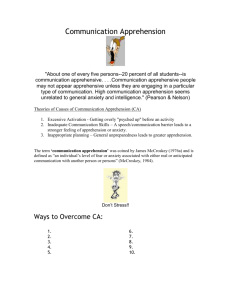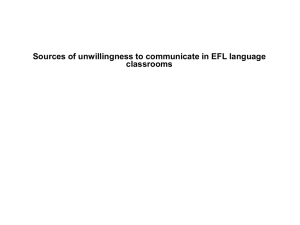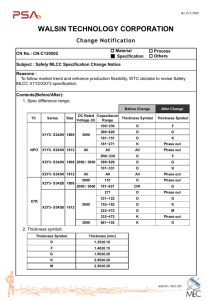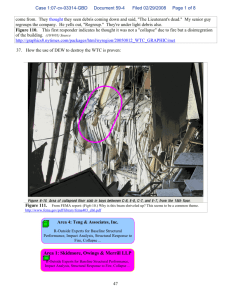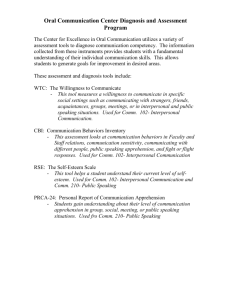I Willingness to Communicate: I Antecedents
advertisement
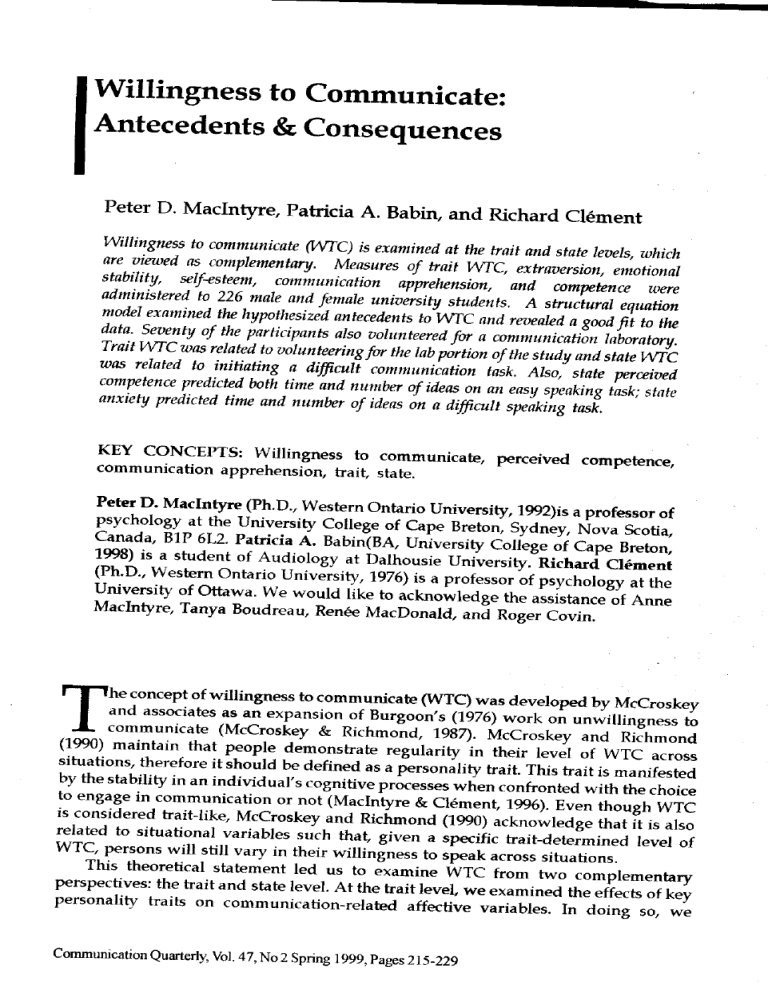
Willingness to Communicate:
I
I Antecedents& Consequences
I
Peter D. Maclntyre patricia A. Babin, and Richard
Cl6ment
willingness to communicate(wC) is examine,
at the trait and statereoels,which
or:,:t!*d
as--complementmy.Measuresof trait WTC, extraoersnn,
,iotio*nt
stability, self+steem, communication apprehension,
and competence Toere
administeredto 226 male an!
(nA3 unioersity stuilents. A structural equation
nodel etnmined hypothesized
antecedents
to"vwc an, reaeared
, lia ji i"'in"
-the
of the parricipantsarsoo-orunteered a communicafion
*'n. !.'y!'v
rnborn
torrtr.
Trait wrC wasreratedto uotunleerin-g the tab for
of thestudy and ,iri i.nttc
for
fition
was re.ratedto
-initiating a dfficuli'conrmunication tisk. Also,"stat pooirra
com*tenceyedictud
both time
"yr:,!n of ideason nn easyspeakingtask;
- ' --"'
state
ryd
anxiety predictedtime and number
of iiteason a dfficult "ryoxihg tas?.
KEY CONCEpTS: Willingness to communicate,
perceived competence,
communication apprehensior; trait, state.
P"aT q. Maclntyre (Ph.D., Western Ontario University,
''2)isa professor of
psychology at the Universip
of Cape S;",
Sydney, Nova Scotia,
!.]bg:
Canada, Blp 6L2. patricia.A. Babin-(BA,u.i"".G
Coliege Ji c"[
s..G
1998) is a student of Audiology at badrousie uii*.rtty.
Richard
cl.ment
(Ph.D., Western Ontario UnivJisity_, 1976)
is u proi"rro, of psychology at the
of
ottawa'
we
wourd
tite
to
a.t<rrowtelge
!-ruyersity
the assistanceof Anne
Maclntyre, Tanya Boudreau, Ren6eMu.Dor,aid,-uid
Roger Covin.
he concept of willingness to comm'rricate (wrc) was
deveroped by McCroskey
and associatesas-an expansion of.Burgoon's
6ezo1wo.k oir ""riirii"g;"r,
,,
communicate (McCroskey & Richmond, 19gZ).
McCroskey and niifr_."a
(1ee0)
maintain-that
.ugJu;ti"';il"t;";;j
rc"e]1.a.1o-""nut"
li']ri. u.ror"
sifuations, therefore it should be defined as a
trait This trait is manifested
iersonality
by the stability in an individuals cognirive p.i.*r.,
*h"r, confronted with the choice
to engage in communication or.notlMaclntyre
& Cl6ment, rsgol- E";" iilorrgh wrc
is considered hait-like, Mclloskey and Richmond (1990)
acknowt.ag; ih"iit r, utro
related to sifuational variables ru.h thrt, given
a specific trait-determined lever of
wrC' personswill still vary in their wilhnfness
to speak acrosssifuations.
This theoretical statement led us to Jxamine
wrC from two complementary
perspectives:the trait and statelevel. At the trait
level, we examined th" "rr..t, or rcy
personalifz traits on communication-related affective
variables. r" a"*g so,, we
CommnnicationQuarterly,Vol.47, No 2 Spring1999,pa ges
215-229
propose a model to represent the psychological processesassociatedwith producing
or enhancing WTC in general. At the state level, we examined variables during a
specific moment in time and within a specific situation (Cattell & Scheier,1963).From
this perspective the present research investigated participants' willingness to
communicateunder specific laboratory conditions. Also included were statemeasures
of anxiety and perceived competenceto examine their effects in a communicative
sifuation.
The Trait Perspectiae
McCroskey & Richmond (1987)maintain that there are a number of antecedents
to WTC, specifically introversiory perceived communication competence,communication apprehension, self-esteem,anomie, and alienation. Becausethe latter two
variables were not significantly linked to WTC in Maclntyrds (1994)analysis of the
antecedentsto WTC, thev were not included in the cument research.However, given
the prominent role afforded communication apprehension in previous theory (for
example, McCroskey & Richmond, 1990) and empirical results (for example,
Maclntyre & Cl6men! 1996)the antecedentswill be expanded to include an additional
personality trait related to the experience of anxiety in general: the dimension of
emotional stability versus neuroticism.
Introoersion/exfrnuersion.
Early researchlinking personality traits with communication (Borg & Tupes, 1958; Carmeng Miles & Cervin, 1965) demonstrated that
introverted people are lesslikely to communicatethan are extraverts.Thus McCroskey
and Richmond (1990)proposed that this trait is an antecedentto WTC. They suggest
that becausean introvert tends to be lesssocially active than an extravert, an introvert
is not required to communicateas often (McCroskey & Richmond, 1990).An extravert,
on the other hand, requires communication to facilitate social interaction and,
therefore, places a higher value on communication.
Enrotionnlstnbility/neurotlcisrn.
Conceptually, emotional stabitity is a trait defined
as broadly as extraversion/introversion and is considered a basic,global trait in both
the Five Factor Model (Costa& McCrae, 1982)and in Eysenck'spersonality typology
(Eysenck, 1970; Eysenck & Eysenck, 1985). Emotional stability versus neuroticism
refers to an individual's typical level of anxiety, worry, and easeof emotional upset
(seeGoldberg 1993). On one hand, persons with high emotional stability tend to be
calm, secure,and self-assured.On the other hand, personswith low emotional stability
show neurotic tendencies such as nervousness/emotional distress, insecurity, and
feelings of inadequacy(Costa& McCrae,1985,p. 2). To the extent that thesetendencies
are realized, a clear effect on self-esteemwould be predicted. Emotional stability, in
combination with extraversion/introversion, has the potential to contribute to the
model of factors underlying WTC, particularly self-esteem.
Self-esteem.
Self-esteemis the perception of self-worth; it is the positive or negative
evaluation of self-knowledge that is included in our self-concept(Rosenberg,'1979).
Self-esteemis a well'researched topic that has implications for not only thoughts and
emotions, but behavior as well (Campbell & Lavellg 1993).An individual with low
self-esteemis likely to be lesswilling to communicate(McCroskey & Richmond,190).
This might be true for a number of reasons.First, people with low self-esteemaremore
sensitive to environmental cues (Campbell & Lavalle, 1D3). As a resulf they will be
greatly affected by the possibility of negative feedback (e.g.,ridicule) that they might
receive and especially prone to communication apprehension. Motivabd by self215
Maclntyre, Babin, and Cl6ment
-
plotectiory a person with low self-esteemwill have a tendency to avoid
sifuations in
which his/her self-esteemmight be threatened. second,a person with low
self-esteem
is apt to beljgve that she/he has nothing meaningful to contribute, thus
he or she will
"&
willing to communicate (McCrosk"y
Ri.h-ond, 1990). Ho*".r"", u,
E 1"*
Mccroskey & Richmond (1990) point ouf self-esteem does not "l*uy,
correlate
significantly with willingness to communicate.The reaso& they maintain,
i, thut ,.lfesteem exerts its influence through other communication variables
such as
communication apprehension and perceived communication competence.
aryrehension(cA). Apprehension is certainly i well-researched
, .Co.mmunication
topic in communication and, according to McCroskey and Richmond (19fJT),
it is
probably the bestpredictor of willingnesi to communicate. Defined
as an individual,s
level of fear or anxiety associated*ith "ith". real or anticipated communication
with
another person or persons,cA is viewed as having a trait-rike quality (Mccroskey
&
Richmond, 1987).Communicati-or apprehension ii also closely li.,kei
m f.r..ived
communication competence (McCroskey & Richmond, 1990).
A pe.so. may
experiencecommunication apprehensionif his/her perceived competence
level is too
Iow for the demands of the current situation (philips, 19g4).Thus, tire
considerationof
how the combination of perceived competence and apprehension
affects onds
willingness to communicate is advisible.
Perceiaed
comnrunicn.tion
competence.
Extrapolating from the work of philips (196g,
1977, and 1984)on reticence,McCroskey and Rrchn ond (1990)maintain
that people
who perceive themselves to be poor communicators are apt to
be less willing to
communicate.we must emphasize that this involves the perccptionof
one,s abilities,
Conceivably, an individual who is acfually a very capable communicator
might not
perceive him/herself as sucll possibly due to low seif-esteemor other
factors. As a
result, this person would tend to have low wrC in spite of high acfual
competence
(Mccroskey & Richmond, 1%0). For this reason, perceived
communication
competenceis expected to be strongly predictive of WTC.
The present sfudv examines the previously-mentioned personality traits
and
communication variables in a strucfural equation model. The model is
arranged such
that the most generalized,broadly-applicable erementsof personality are
shoin to the
left and_the more specific, circumiiribed variabres "pp.a, to the
right Relations
among the variablesare representedby arrows which indicate that if one"were
to affect
change in an antecedent variable, changes in the subsequent variable
would be
expected.The magnifude of the resurting change would be predicted
based on the
magnifude of relation between the two variablei, u, ."pr"r.rrit d by the
empirically_
derived coefficient associatedwith the arrow. The ud.qrru"y or ine
moddt can be
evaluated based on the ability of the proposed moclel to iccount for
the correlations
among the variables obtained from the acfual data. strucfural equation
models
combine confirmatory factor analysis, which defines the latent variables,
with path
analysisto assessrelationsamong latent variables.
Exam.ining the conceptuarmodel in Figure 1 from left to righ! we
begin with
.
extraversion and emotional stability, move to an intermediate le-vel
represented by
self-esteem,and conclude with three variables specifically related to cori-rmunication.
Consistentwith McCroskey-and Richmond,s
lUiO; ttreoreUcaldiscussion,*. p.opor"
that basicpersonality variibles ultimately .*".t *r"i. influence on wrc
tiro.r'gir such
variables as self-esteem,communication anxiety, and perceived computencJ.
Links
were drawn from extraversion to both perceived competence and
c-ommunication
WTC Antecedents & Consequences
2t7
apprehension.An extravert should be more likelv to have communicative exPerience
und thrrc feel more competent in his/her abilities. We also hypothesizethat extraverb
would be lower in communication apprehension. Both extraverts and emotionally
FIGURE I
ConceptualModel
NOTE: EXTRA =
EMOT =
ESTEEM :
=
APP
COMP =
=
wTC
EXTRAVERSION
EMOTIONALSTABILITY
SELF.ESTEEM
APPREHENSION
COMPETENCE
WLLINGNESS TO COMMUNICATE
to have higher self-esteem because their social
stable persons are predicted
(see McCrae & Costa, 1990).
interactions
'Based would be more positive
on McCroskey and Richmond's (1990) analysis, self-esteem is hypothesized
to affect wTC through communication apprehension. consistent with Maclntyrds
(1994) model, the two most immediate antecedents of wTC are communication
apprehension and perceived communication competence. Finally, a path was drawn
between communication apprehension and perceived competence based on the
hypothesis that persons who are highly anxious will tend to rate themselves as lower
in perceived competence (see Maclntvre, Noels and Cl6men9 1996).
{
The State Perspectioe
In addition to testing the proposed antecedents of wTC at the trait level, the
current sfudy also investigates the impact of a particular situation on state wTC in a
(1989) asked laboratory
laboratory. Zakahi and Mccroskey
communication
to
a
few questions. That study
to complete a questionnaire and respond
participants
-began
on
wTC
and 89 who scored low.
high
with a pool of 87 individuals who scored
were contacted and
group
each
from
Twenty-five iandomly selected participants
who scored high
the
respondents
92/o
of
asked io come to a lab. Results revealed that
but only 24/o of
sfudy,
laboratory
in
the
on the wTC scale were willing to participate
(Zakahi
& McCroskey,
participate
to
willing
those who scored low on the scale were
could
possibly be a
that
wTC
proposed
1989). As a result of their findings, they
extends the
research
present
The
research.
confounding variable in communication
come to a
only
to
not
participants
(1989)
by
asking
study
zakali and Mccroskey
tasks.
communicative
and
written
oral
laboratory but also to engage in both
Because communication apprehension and perceived competence are proposed
218
Maclntyre, Babin, and Cl6ment
'!
as the most immediate antecedents to wTC at the trait level (see Maclntyre, 1994),
these variables were further examined as " state'' variables in a communication lab as
well. The state reactions observed in the lab will reflect more than just the influence of
relevant trait-like variables. States potentially will be affected by several variables
including mood, physiological factors (e.g., arousal levels), environmental conditions
(eg., the presence of recording equipment), and a host of other factors. previous
research on both apprehension and perceived competence indicates that these
variables are associated with acfual communicative
behavior (Richmond &
McCroskey, 1"985).
In the present sfudy, measures of the communicative behavior displayed in the lab
wiff ue taken. specifically, time spent communicating and the number of ideas grven
will be recorded. These indices were chosen because they are relatively objective
measures of behavior that can be preclicted by the state-level measures of wrC
communication apprehensiory and perceived competence in a regression equation.
Given that wrC is defined by the intentio n to initiate communication, the time spent
communicating and the number of ideas generated will likely be more strongly
affected by communication apprehension and/ or perceived competence.
The specific research questions and hypothesis involved in the present research
are as follows:
RQ1:
H1:
H2:
RQ2:
Will the proposed structural model of antecedenb to WTC account for
the correlations observed by measuring those variables?
Those who volunteer for the laboratory will be higher in haitJike
WTC than those who do not volunteer.
In the lab, those higher in state WTC will be more likely to initiate
communication, both oral and written. Participants lower in WTC
will be more likelv to refuse. Corresponding differences in anxiety and
perceived communication competence also are expected.
Which state variable, willingness, anxiety or perceived communication competence, will best predict the number of ideas and length of
time spent communicating?
METHOD
Participants
Participants werc 226 male and female university sfudents (53 males and 771
femaleswith the sex of two participants not reported) ranging in age from 17 to 47
years with an mean age of 27 years. They were enrolled in lnterpersonal
Communicatiory Introductory Psychology,Personality Psychology,and Introductory
Englishuniversity-level courses.The lntroductory Psvchologysfudentsreceivedextra
credit in the form of bonus points for participation in this study. From this pool of
participants, 86 volunteered for the laboratory portion of the study. Sixteen
participantsdid not keep their appoinhnent possibly becauseof illness, forgetting the
meeting, or changing their minds about participating. Data for a total of 225
participantswere available for the trait-level analysis,and a subsetof 70 participants
provided data for the laboratory portion of the study (state.levelanalysis).
Materials
Five scales were used to measure willingness to communicate, perceived
WTCAntecedents& Consequences
219
competence, self-esteem, extraversiory emotional stability, and communication
anxiety. An additional speaking and writing task questionnaire was also developed
and administered. Descriptions are as follows:
Trait koel
Willingness to Communicate Scale(McCroskey & Richmond, 1990). This is a 12-item
scale that asks respondents to indicate how willing the1, would be to communicate (0%
- 100%) in various situations (e.g., public, meeting, group/ or dyad) and with various
interlocutors (e.g., stranger, acquaintance, or friend). Following McCroskey (1992),
"filler
items" were administered but the corresponding data were not analyzed.
eight
A reliability analysis found CronbacKs alpha coefficient to be .90. This scale was
willingness
with
friends,
into three observed variables; namelp
divided
acquaintances, and strangers. Factor loadings in the strucfural model for these
variables were .61 for friend, .91 for acquaintance and .56 for stranger.
Self-PerceioedCompetence Scale (McCroskey & McCroskey, 1988). This 12-item
scale was used to measure perceived competence. The scale emplovs a strucfure
similar to the WTC scale and measures perceived competence in communicating with
friends, acquaintances, and strangers in dyads, meetings, groups/ and in public. A
reliabililv analysis produced a Cronbach's alpha coefficient of .89. This scale was
divided into the three observed variables, competence with friends, acquaintances,
and strangers. The factor loading for friends was .58, for acquaintances .97, and
strangers .63.
Comnnmication Aryehension Scale(McCroskey, Richmond, and McCroskey ,198n.
"L2-item
scale, using a strucfure similar to the two preceding scales, was used
This is a
to measure communication apprehension with friends, acquaintances, and strangers
in dyads, groups, meetings, and in public. Cronbach's alpha coefficient was found to
be.88. This scale was also divided into apprehension with friends, acquaintances, and
strangers with factor loadings of .60,.87, and .78, respectively.
Self-Esteem(Rosenberg, 1979). This is a 1O-item questionnaire measured on a ninepoint scale. Cronbach's alpha coefficient was determined to be .85. This scale was
divided into three variables (defined by the sum of the first three items, the middle
three items, and the final four items) with factor loadings of .82, .81. and .74,
respectively.
Trnnspmmt Bi-PoIm Inoentory (Goldberg, 1992). This is a 35-item scale used to
measure the big five personality traits. However, only the fourteen items
corresponding to extraversion (CronbacKs alpha coefficient = .73) and emotional
stability (Cronbach's alpha coefficient = .74) were used. Both variables were measured
with 7 items on a nine-point scale. Each latent variable was represented by three
observed variables based on the sum of the first two items, the next two items, and the
final three items. The factor loadings for extraversion were .78, .69, and .62. The
loadings for emotional stability were .67, .79, and .76.
Communication Tasks. A 20-item list of speaking and writing tasks (10 each) was
developed and administered for the purpose of selecting tasks to be administered in the
communication lab (see Appendix A). Although the items in the list were not used as
a scale, reliability estimates revealed a degree of communality among responses to the
items (20-item alpha =.82, 10 speaking items alpha = .69, and 10 writing items alpha
= .72).
Respondents were asked to indicate how willing they would be to do each of the
220
Maclntyre, Babin, and Cl6ment
tasks' From this set of questions, tasks were selected that would be appropriate
for
communicating for three minutes and were also chosen so as not to give
any one group
of sfudents an advantage. For example, question number 12 wis
a task tha! on
average/ respondents reported that they were unwilling to do, but
this question was
not chosen because it was thought that students maioring in English
might have an
unfair advantage.
A subset of four tasks (see communication Trzsk below) was chosen
for the lab
portion of the sfudy. The choice was based on the responses available
before the first
lab session was conducted (n = 114). one writing task and one speaking
task were
chosen based on an average above four on a- five-point scale,
indic"ating high
willingness. These were designated as "easy tasks." one speaking
and one writing task
were chosen based on a mean berow three, indicating row wiliingness.
These were
classified as "difficult tasks."1
State Leztel
The above trait-level, meas-ures are inappropriate for measuring
state reactions,
Following research by walk (1956) and ltairntyre and Gardner
1isot1, in order to
obtain the required ratings expeditiously, a thermometer-shaped
figure'was used for
each of three state variables, willingness, anxiety, and perceived"competence.
The
three state measures were presented on a single sheet of paper. parHciparits
made four
sets of these ratings, one corresponding to eich of the tasks below:
willi,gness.
Respondents were asked to judge how willing they would be
to
perform each task (scale of 1 to 10).
Respondents-were asked to judge how anxious they felt about performing
-Anxlety.
each task (scale of 1 to 10).
Perceioedcom?etence.Respondents were asked to indicate how competent
they felt
.
about performing each task (scale of 1 to 10). participants were
asked to perform the
following communication tasks, each within a three-minute time
limit:
Communication Task. The following four tasks were administered
in the lab
portion of the study: (1) speak about your favorite hobby (easy), (2)
describe the
educational system in some detail (diffiiult), (3) write a posicard
tllhg a friend what
the urriversity is like (easy), and (4) write a short essay concerning
federal control on
immigration (difficult).r
Procedure
Participants were given the scales 1-6 during regularry scheduled
classes. The
questionnaires were administered in two different random orders.
sfudenb also were
asked to volunteer for the laboratory portion of the sfudy. If they
agreed, they were
asked to sign the bottom portion of the consent form and t"
p"oJiau u Lt.pr,or,.
number. Volunteers were contacted and asked to come to the
lab individually. when
participants arrived, their name and phone number were
removed from the
questionnaire and destroyed; all were assured that
participation was strictly
volurrtary and that thev could refuse to answer any quesuon.
Participants were told that they would be askedto consider doing
four tasks - two
speaking and two writing tasks. Before proceeding, however, participants
were shown
each task and then asked to fill out 16-point stati measures indicating
how anxious,
willin& and competent they felt at that parficular moment about
pJrforming each
task. Participants were asked to provide these three ratings even
if they did not intend
WTC Antecedents & Consequences
221
to do the task. They were also informed that they would have a three'minub time limit
for each task, and could speak or write as little or as much as they wished within this
time period. This procedure was repeated for each of the four tasks.
The two speaking tasks were performed first starting with the easy one.
Participants' responses were recorded on audio tape. The writing tasks were
performed nex! again the easy task was completed first. The spoken and written
responses for each participant were coded on the basis of the amount of time (in
seconds) it took to complete the task and the number of ideas communicated.
Before examining these results, an inter-rater reliability analysis was performed
on the coding of the number of ideas spoken and written by a randomly chosen sample
of participants (n = 33). Results revealed a correlation ol r = .99 for the easy speaking
task and r = .94 for the difficult speaking task. The inter-rater reliability analysis for the
easy writing task was r = .94 and r = .94 for the difficult speaking task, indicating very
good reliability in the coding of the data.
RESULTS
The results will be introduced in four parts: (1) a trait-level structural model to
exarnine antecedents of WTC; (2) a t-test to determine whether those who volunteered
for the lab have higher WTC than those who did no! (3) multivariate analyses of
variance (MANOVAs) to examine the differences in state willingness, anxiety, and
perceived competence between those who chose to perform each particular task and
those who did no! and (4) m ultiple regressions to examine state predictors of time and
number of ideas communicated on each task.
Trai t-leael
A structural model, analyzed using AMOS 3.5 (Arbuckle, 1995), was evaluated on
the data collected from the survey measures of the trait variables. A covariance mahix
with listwise deletion and standardized estimates was utilized in the analysis.2 The
present analysis revealed a good fit for the model of the antecedents of WTC (see RQ1).
The chi-square for this model was significant (1'([21., N = 226)= 207.28, p < .05)
indicating significant residual variance in the covariance matrix. However, the ratio
of chi-square to degrees of freedom (1.71) indicated a good model . The goodness of fit
index (GFI) = .91, the adjusted GFI = .88, the TLI = .94, the CFI = .95, and the NFI = 90
all indicated a good model (Note: Goodness of fit indexes with a value of 1.0 indicate
a model that fully accounts for the correlations obtained). For a discussion of the
evaluation of fit indices, see Arbuckle (1995) and Hu & Bentler (1995).
Within the model, eight of the nine paths shown in Figure 2 were significant (f >
2). Moving from left to right the correlation between the two exogenous personality
variables (extraversion and emotional stability) was positive (.49). There were positive
paths between extraversion and both self-esteem (.33) and perceived competence (.35)
and a negative path from extraversion to anxiety (.28). This indicates that an
extravert is likely to feel competent about his/her communication abilities, is likely to
feel less anxious about communication, and is also likely to have higher self-esteem.
There was a positive path leading from emotional stability to self-esteem (.57)
indicating that an individual who is higher in emotional stability is also likely to have
high self-esteem.
Moving farther along on the model, a negative coefficient was found between
communication anxiety and communication perceived competence C.33); a highly
222
Maclntyre, Babin, and Cl6rnent
q
FIGURE 2
Snucnral ModelResults
NOTE: ex l, el & ex 1 areindicatorvariablesfor extraversion
emI , em2-& ern3areindicatorvariablesfor emotionalstability
esl, es2& es2areindicatorvariablesfor self_esteem
*Nonsignificantpath
Legend:
:
eilra
emot =
ssteem =
:
app
comp =
=
wtc
extraverslon
emotionalstability
self-esteem
apprehension
competence
willingnessto cormnunicde
strg,= stranger
rno =
acq =
O =
f---"1=
mend
acquaintimce
latent variables
observed variables
anxious communicator is less likely to feel competent about his or her abilities.
The
path between anxiety and willingness was nonsignificant (t < 2). perceived
competencewas found to be the bestpredictor of an individual,s wrC witir very
strong
path
in this sample. Finallp at the farthest end of the model, two latent
-(.84)
variables- friends and shangers-were included to help account for measurement
variance_commonamong th9 wrg perceived competenceand apprehension
scales.
The factor loadings for the latent variable friend on the observed friend variables
were as follows: friend anxiebz.37, fuiendcompetence-.60 and friend willingness _.59,
The factor loadings the latent variable shangei were as follows: stranger ui*i"ty
.zr,
stranger competence -.78
stranger willingness -.42. An attempt"was made to
-and
include a latent variable for acquaintance,bui was removed becauseit introduced
problems with model identification.
State-leael
In order to determine whether there was a significant difference in wrc between
thosewho volunteered for the laboratory poruoriof this sfudy and thosewho
did not,
a one-tailed t-test was conducted (seeH2). The mean wrc ;f the group who
did not
attend the lab was M = 735.60while the mean wrc of those who iolunteered
for the
Iab was M = 786.23.A t-test revealgg-gut the group who attended the laboratory
reported significantly higher wrc (f(209)= 1.T9,p <.tts; than the group who did
nol
This indicates that wrC was related to the decision to volunteeifor ihe laboratory
WTC Antecedents& Consequences
223
portion of the study.
The third hypothesis predicts differences in the state measures of willingness,
anxiety, and perceived competencebetweenthosewho agreed and thosewho refused
to communicate.To addressthis issue,two multivariate ANOVAs were performed on
the data from the difficult speaking and writing tasks. The easy tasks were excluded
from the analysis becausenobody refused the easy writing task and only one person
refused the easy speaking task, making it impossible to statistically compare people
who communicated with those who refused.
The analysis of the difficult speaking task revealed a significant average
correlation among the dependent variables (averager = ,233,p < .05) and a significant
multivariate effect (Pillais3 = .151 p < .05). Subsequent univariate tests showed
significant differences only for state WTC (F(3,66)= 6.23,p < .05). Inspection of the
means revealed that those who initiated communication had much higher scoresfor
state WTC (M = 7.18) than those who refused (M = 1..43).A similar multivariate
ANOVA was conducted on the difficult writing task.The dependentvariables showed
a significant averagecorrelation(r = .542,p < .001)and a nonsignificant Box M test (Box
M=6.37,p<.44).Asignificantmultivariateeffectwasobtained(Pillais=.153,p<.05).
At the univariate level, a significant difference in error variance was observed
only for the anxiety rating (F (1,68) = 11..38,p < .001). Univariate tests for mean
differences revealed significant effects for both WTC (F(3,66)= 11..98,p < .01) and
perceivedcompetence(F(3,66)= 4.78,p <.05). As with the speakingtask, the meansfor
the difficult writing task showed that those who initiated communication had higher
scoresfor stateWTC (M: 5.65)than thosewho refused (M = 3.22).The meansfor state
perceived competenceindicated that those who complied indicated higher ratings of
perceived competence(M : 3.52) than those who did not comply (M = 2.22).
To address the second research question (RQ2) and determine whether
willingness, anxiety, or perceived competencebest predicts the number of ideas and
length of time communicated in the lab eight stepwise multiple regressionanalyses
were conducted.The reasonfor conducting 8 regressionsis to avoid combining the two
criterions, time and number of ideas, into an aggregatevariable whose scoreswould
be difficult to interpret, even if the data were standardized. Conceptually, there are
differencesbetweenspeakingand writing that justify keeping them separate.Also, the
easy and difficult tasks produce clearly different effects from anxiety and perceived
competence.a
The two criterion variablesin the regressionswere (1) time spent speaking and (2)
number of ideas communicated for the easy speaking tas( the difficult speaking tasl
the easy writing task, and the difficult writing task (yielding 8 regressionequations).
The three state variables (willingness, anxiety, and perceived competence)measured
for eachtask were useclas the predictors. For the easyspeaking task, results indicated
that only perceived competencepredicted speaking time (p= .314;t(@) = 2.62,p < .05)
and number of ideaspresented($= .345;t(64)= 2.92,p <.01). For the difficult speaking
task, only anxiety predicted speaking time (?= .305;t(62) = 2.51,p < .05) and number
of ideas (F = .340;t(62) = 2.83,p < .01). There were no significant predictors for either
of the writing tasks.
DISCUSSION
Two researchquestionsand two hypotheseswere examined in this paper. First,the
proposed strucfural model of trait-level data was tested.Second,it was hypothesized
224
Maclntyre, Babin, and Cl6ment
that those who volunteered to attend a communication lab would be higher in WTC
than thosewho did not. Third, itwas hypothesized that thosewho were higher inWTC
would be lessapt to refuse to do the communication tasks.Finally, the secondresearch
question asked which state variable would best predict the number of ideas and time
communicated for each task?
The structural model supports McCroskey and Richmond's (1990) proposed
antecedentsof WTC. Surprisingly, however, a nonsignificant path was found between
communication apprehension and WTC. Contrary to McCroskey's theory, in this
study apprehensionexerts its inlluence on WTC only through perceived corrpetence,
although this result might be a statistical artifact of the unusually strong relation
between perceived competence and WTC. ln examining communication contexts
involving second language use, Maclntyre and Charos (1996) also found that
perceived competencewas more strongly related to WTC than was communication
apprehension.The present resulb suggestthat if communication apprehensionis low,
an individual's perceived competenceis likely to be higher, which in furn leads to a
greater willingness to communicate.
Phillips (1984) argues that a preoccupation with apprehension about
communicating can have a direct impact on an individual's level of perceived
competence.Furthermore, people who feel they are competent communicators are
inclined to seek out circumstancesin which they can cultivate their communication
skills (Richmond & McCroskey, 1985).This would explain the very strong path found
from perceived competenceand WTC. This explanation would also account for the
paths from extraversion to perceived competenceand apprehension. By definitiory
extraverts tend to be socially active individuals and therefore, tend to have more
opporfunities to gain communicative experience.This, combined with higher selfesteem,would serve to lower their apprehension about communicating (Eysenck &
Eysenck, 1985).
Discussionof the results of structural equation models frequently usethe language
of causality. Indeed, this analytic procedure is often called "causal modeling" or
"causal analysis." Essentially the procedure tests whether
a particular proposed
model is supported by an obtained correlation matrix in the sense that the model
accountsfor thosecorrelations.The resulting model does not allow for the inferenceof
causality, but does indicate where the correlations are consistent with the proposed
strucfure and where expected relations are not observed.The nafure of the causality
shown in the model is that if one were to make changesin an antecedent,then changes
in another variable would be expected. Subsequent research, designedto test for
causality, is required.
In addition, the model may be useful in generating hypothesesto be tested. For
example,based on the model in Figure 2, one can hypothesizethat if an experimenter
reduced apprehension among a group of communicators, then an increase in
perceivedcompetencewould be expected. If the experimental procedure succeededin
increasing the perception of communication competence, then increases in WTC
would be predicted. Conversely,increasingapprehensionwould be expectedto lower
perceived competenceleading to a reduction in WTC.
This study supported and extended Zakahi and McCroskey's (1989)researchon
WTC as an important variable in communication research.The finding that thosewho
volunteered for the laboratory portion of the study scoredsignificantly higher on WTC
than thosewho did not was replicated. Although Zakahi and McCroskey interpreted
WTC Antecedents & Consequences
225
this as a confounding variablg the result sheds light on the validity of the WTC
concept Clearly those who chose to volunteer for a communication lab were
indicating a willingness to enter a sifuation in which communication would be
expected. In fact, this is evidence in favor of the key hypothesized effect of WTC, that
is, choosingto communicate when given the opportunity. should a researcherwant to
obtain a sample of participants with a broader range of levels of willingness, he/she
might make attending the laboratory a course requirement so that larger range of
levels of willingness to communicate among participants may be obtained. Fufure
research might also have respondenb fill out a WTC scale and then observe
communication in a more naturalistic setting where the focus is on the interlocutor
who initiates conversation.
Once in the lab additional effectsof WTC were observed.The only statevariable
found to differentiate those who choseto initiate a responsefor the difficult speaking
task from thosewho choseto refuse was wrC. For the difficult writing task, statewrc
and perceived competencedifferentiated those who responded from those who did
not we have already noted that thosewho attended the lab were higher in wrc than
thosewho did not. Therefore,willingness not only influenced who volunteered for the
lab, but also affected whether they completed the communication tasks once in the
laboratory situation. This offers strong support for Mccroskey's definition of wrC as
the probability of initiating communication when given the choice to do so.
In terms of actual communication behavior, the multiple regression analysis
revealed that perceived competencepredicted both the speaking time and number of
ideas for the easyspeakingtask, while anxiety predicted the time and number of ideas
for the difficult speaking task. Anxiety likely played a negligible role in the easy
speaking task simply becausethe topic (i.e., speak about a hobby) was familiar and
non-threatening. Only one person refused to respond indicating simply that he/she
had no hobbies. Perceivedcompetencemight have played a larger role in the writing
task becausehigher competence allows one to offer more detailed, elaborate responses,
especially when the task is relatively easy and open-ended. on the more difficult
speaking task, anxiety emergesas the best predictor. This may reflect a disruption of
cognitive processesthat accompaniesanxiety arousal (Eysenck, 1979). In essence,
more anxious speakers tend to show higher concern with self-presentation and
potential embarrassment,so that if the individual believesthat she/he might not make
a good impressiory anxiety can be aroused (Leary & Kowalski, 1995).Anxiety might
ariseeven if the speakerperceivesthat the impact he/she is making is good, but yet not
up to their personal standards (Leary & Kowalski, 1995). ln essence,heightened
anxiety seemsto override the effect of perceived competenceon the difficult tasks.
The results of this study help to clarify the concept of WTC. By definition, WTC
deals with the decision to initiate communication. we found that wTC did indeed
predict participanb' volunteering for the communication lab. Furthermore,
consistentwith McCroskey and Baer/s(1985)definitioru wTC affected the decisionto
initiate communication during the lab. In fact wrc was the sole predictor of those
who attempted difficult speaking tasks, when given the choice. Apparently, once
communication has been initiated, the influence of WTC is complete and other
communication variables (anxiety and perceived competence)play more dominant
roles.
Thesetrait-level and statelevel results are complementary and can be integrated.
we would argue that traitlevel wrC prepares individuals for communicative
226
Maclntyre, Babin, and Cl6ment
experiences by creating a general tendency to place themselves in situations iir which
communication is expected. within a particular sifuatiory state wrC predicts the
decision to initiate communication. After communication begins, other state
variables, such as apprehension and perceived competence,exert a greater influence
on communicative behavior. In furn, thesevariables likely act as antecedentsaffecting
the person's WTC the next time opportunity arises (Beatty, 19gg).
In conclusiory itcan be seenfrom these results that trait willingness may bring an
-once
individual into sifuations in which communication is likely. However,
in a
particular sifuafion, state willingness can influence whether communication takes
place. If communication does occur, then other variables important to
communicatiory such as anxiety or perceived competence,become more relevant to
communicative behavior.
APPENDIXA
Directions:
Please lndicate how willing/unwilling
following:
5 - definitely yes
4 - probably yes
3 - unsure
2 - probably no
1 - definitely no
1.
2.
J.
4.
J.
*
6.
7.
8.
9.
10.
11.
1.2.
lJ.
1.4.
#
#
#
ID.
lb.
1.7.
18.
19.
20.
you would be if asked to do the
Write a note telling your friend whete you are now and whattime you,llhome.
Describe the role of parliament in the Canadian govemment.
Speakabout your favorite relative and explain why this person is your favorite.
Write about your favorite t.v. show.
Talk about the pros and cons of capital punishment.
Write a postcard telling a friend what the university is like.
Describethe educational system of your home province/state in some detail.
Describethe layout of your bedroom.
Write down three things that you would like to receivefor your birthday.
Discussthe idea that a person should seekcommitment rather than freedom.
Write an advertisementfor a bicycle.
Discussthe idea that poets are the unacknowledged legislatorsof the world.
Discussthe coursesyou are taking at your university.
Write a short essayconceming federal control on immigration.
Give Directions from one familiar landmark to another.
Write down your skills in such a manner as if you would be applying for a job.
Speakabout your favorite hobby.
Write about the culture of your country and what it means to you.
List three benefits and three problems with unions.
Write a short essay conceming asking for course credit for extracurricular
activities.
" - Taken directly or adapted
from WaII (1977).
# - Taken directly or adapted from Maclntyre, Noels & Cl€men t (199n.
NOTES
WTC Antecedents & Consequences
227
1 To address the issue of whether higlr and low WTC participants found these tasks relatively
,,east',or,,dlthculf,,amediansplitontfait-likewTCscoreswasperformed.Thespeakingtasks
and writing tasks were then ranked within each wTC group. Both high and low wTC
participants ranked the easy speakingtask as the one they were most willing to do. Both high
and Iow WTC participants ranked the difficult speakingtask as the one they were third least
willing to do. The difficult writing task was ranked as the one both groups were least willing
=
to write. The easy writing task was ranked secondby the high wTC group (mean 4.47 out
=
both
within
that
indicates
of
5).
This
of 5) and third by the low WTC group (mean 4.41 out
tasks
and
both
easy
to
do
willing
relatively
high WTC and low WTC groups, participants were
relatively unwilling to do both difficult tasks.
2 This matrix can be otrtained from the first author.
3 Following Tabachnickand Fidell (1996),the Pillaisstatisticwas chosenforthis analysisbecause
the test for equality of covariancematriceswas significant (Box M - 33.9,p < .001).A local test
(advocatedby Kirk, 1995)for homogeneity of error variancesuggestedthat only the anxiety
=
rating produced significantly different error variancesfor the speakingtask (F (1,68) I2.2, p
were
violations
therefore
these
were
interpreted,
WTC
< .001).Only the univariate effectsfor
results.
of
the
the
meaning
not consideredto have a major impact on
a Finally, a 2x2within-subjects ANOVA, with the factorsmode of communication (speakingvs.
writing) and difficulty level (easyvs. difficult) revealeda significant interaction for both of the
dependentvariablesused asthe criterion rn the regressionanalyses,number of ideas (F (1',67)
= 7.67, p < .01) and time (F (1,69) = 9.23, p < .01). This indicates that there are sigmficant
differencesacrossthe tasks,as is evident from the regressions.
REFERENCES
Chicago,IL: Smallwaters Corporation'
(1995).
Guide.
Amos lfser's
Arbuckle, J. L.
correlatesof public speaking anxiety. Conpredispositional
Beatty,M. J. (1988).Situational and
municationEducation,37, 28'39.
Borg W.R., & Tirpes, E.C. (1953).Personality characteristicsdated to leadership behavior in
two types of small group situational problems. lournal of Applied Psychology,42, 60-69.
Burgoon, J. K. (1976). The unwillingness-to-communicatescale: Development and validation.
ConmunicationMonographs,43, &-69.
campbe[ J. D., and Lavallee, L. F. (1993). Who am I? The role of self-conceptconfusion in
understanding the behavior of people with low self-esteem.In R. F. Baumeister(Ed.). Sefesteemthe puzzle of law self-regard.(pp' 3'20). New York: Plenum Press'
Carment, D. W., Miles, C. G., & Cervin, V.B.(1965).Persuasivenessand persuasibility as related
4,1-7.
to intelligmce and extraversion. British lwmal of socialand Clinical Psychology,
Champatgn,
(2nd
Ed.).
anxiety
scab,
IPAT
the
(1953).
Handbook
I.
H.
cattefl, R. B. & scheier,
for
Testing'
Ability
and
IL: Institute for Personality
EysenclgH. J. (1970). Thestructureof humanpersonality,3'ded. London: Methune'
Eysenc! H. J. (1975). Theinequalityof man. San Diego, CA: Edits Publishers'
New York: Plenum
Eysenc! H. J. & Eysenck,M. w. (1985).Persotalityand indiaidualdit't'erences.
Press.
Eysenc! M. W. (1979).Anxiety, leaming and memory: A a reconceptualization.lournal of Re'
searchin Personality,13, 35&385.
Goldberg L. R. (1992).The development markers for the big-five factor structurc. Psychological
4, (D 2e2.
Assessment,
Goldberg L. R. (1993).The structure of phenotypic personality fiaits. AtnericanPsychologist,
48,(1) 2C34.
228
Maclntyre, Babin, and Cl6ment
Hu, L'T., & Bentler p.M. (199s). Evaluafing model fit. In
R. H. Hoyle (Ed.). structurar equation
modeling: Concepts,issues,and applications. Lond,on: Sage publications.
Kirk, R E' (1995)' Experimentaldesign: Procedures the
iehaoioralsciences(3d edition). New
for
York: BrooksCole.
Leary, M' R' & Kowarski, R.M' (1995). sociaranxiety.London:
The Guildford press.
Maclntyre, P. D- (7994).variables underlying *ilii.,gr,"",
to communicate: A causal analysis.
CommunicationResearch
Reports,11(2), 1.35_.1.42.
Maclntyre, P D' & Cl6ment R. (1996). personarity,apprehension
and contpetence
as infruenceson
utillingnessto communicate
and communication
yrrquirry. poster presented at the *orrd Con_
gressof Psychology,Montreal, Canada.
Maclntyre, P D. & Gardneq,R. c. (1991).Languageanxiety:
Its r€lation to other anxietiesand to
processrngin native and secondlanguage.LanguageLearning,47,
Sl3_534.
McCrae, R. R., & Costa, P.T., Jr.(19t37).Validation of t-he
five-fac"tor model of personality across
instruments and observers. lourtul of personalityand Socialpsychology, gLg{..
SZ)
McCrae, R. R., & Costa, p r., Jr. (1990). personalityin adurthood.
New york: Guirforcrpress.
Mccroskey, J. C. & BaeaJ.E.(1985).willingnes to cimmunicate:
Theconstructand itsmeasurement.
Paperpresentedat the annual convention of the SpeechCommunicaton
Association,Denver,
co.
McCroskey, J. C. & McCroskey, L- (19gg). ser-f-report as an
approach to rneasuring communicatlon competence, CommunicationResearchReports,5(2),
106713.
Mccroskey, J. & Richmond, vp (1990).willingness to communrcate:
A cognitive view . rn CommtLnication,cognition,and anxiety.(pp.19-27). Selectpress.
McCroskey,J' & Richmond, u. p. (798n willingness to communicate.
In J. McCroskey & J. A.
Daly (Eds.).Personarityand interpersotnlconriunication:vor.
6. Newbury park: sage publica_
tions.
Phillips, G' M. (1968).Reticence:pathology of the normar
sp eaker.speechMonographs,3s,3949.
Phillips, G. M. Q9m. Rhetoritherapy versus the medical
model: Dealing'wrth reticence.
ConmunicationEducation,26, g4_43.
Phillips, c' M. (1984).Reticence:A perspective on sociar
withdrawal. In J. McCroskey & J. A.
(Eds') Aaoidingcontmunication.
(pp.57-66). Beverry Hills: Sagepublications.
- Puly
Richmond, V. P. & McCroskey,J. (1985).Communication:Apprehensiin,
aaoidance,
and effectiue_
ness.Scottsdale,AZ: Gorsuch Scarisbrick,publishers.
Rosenberg M. (1979). Conceiaingtheself. New york: Basic
Books,Inc., publishers.
Thbachnick,B G & Fidell, L. s. (1996). IJsingmultirariate
statistics.New york Harper Collins.
wafk' R. D' (1956)'self-ratings of fear in a feir-invoking srtuati
on.lournal of Abnormaland social
Psychology,52, MB-457.
\Na.D'.c'(1977)'Debate:A guide Canadianstudents.Halifax:
for
Atlantic tnstitution of Education.
zakahi, w' R. & McCroskey,J. c. (1989). willingness to communicate:
A potential confounding
variable in communication research. CommunicationReports,
2, 96-1M,
WTC Antecedents & Consequences
,)a

